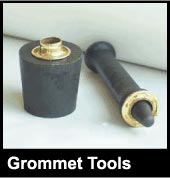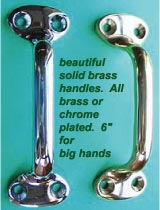
 Custom Search
|
| boat plans |
| canoe/kayak |
| electrical |
| epoxy/supplies |
| fasteners |
| gear |
| gift certificates |
| hardware |
| hatches/deckplates |
| media |
| paint/varnish |
| rope/line |
| rowing/sculling |
| sailmaking |
| sails |
| tools |
| join |
| home |
| indexes |
| classifieds |
| calendar |
| archives |
| about |
| links |
| Join Duckworks Get free newsletter CLICK HERE |
|
|
| The Micro Camper Cruiser |
design by Ken Simpson |
The following is a record of the design, build and use of the newest ship in my portfolio, the MICRO CAMPER CRUISER. Although similar to the larger sister ship, the Mini Camper Cruiser, it has definite advantages and some disadvantages. Let me briefly explain. Both are modular, and essentially fold in half for transport and storage. The MINI is 13 feet long and 4 feet wide on the water, while the MICRO is 8 feet long and 3 feet wide. That tells a lot about their potential use. It is obvious the MINI is intended to carry a few people, and it sleeps two comfortably. The MICRO, on the other hand, is dedicated to the lone sportsman or woman, with an occasional guest. It sleeps only one! But, it can carry up to a 350 pound load, which includes the occupant, or two, the sporting gear, and a motor and battery of choice. And, it fits in all Trucks, SUV's and even some Hatchback Cars. That is it's real advantage. Weighing only 80 pounds, it is easy to lift, move around, or drag to the water. The beauty of the design is that it is adaptable. The builder has a clean sheet to make improvements, add use-specific fixtures, and even scale it to their transport needs and creature comfort wishes. The following is the Design Page of the plans, which provides dimensional information, as well as hull form options. As you can see, the outline is composed of simple flat surfaces, nothing fancy, unless you want it. The basic hull is reasonably small, 8'L x 3'W x 1'H and sturdy, but with the added cabin and rear enclosure, it takes on the appearance of a larger boat. And that's intentional. The MICRO does not have to be only for those that want to spend the weekend in some remote lake area, it also makes a great little day cruiser for a small family. And, it offers some protection from the elements if necessary. Try that in a canoe or kayak. Oh yes, this little boat rows very easily, and can also be paddled by one or two. The option of a trolling motor only extends the distance traveled, as top speed is determined by the displacement hull size, and for the MICRO that is about 5 mph maximum. Now, with a 2.5 hp outboard it would be possible to get up on plane, and achieve a speed of 7 or 8 mph, if not more. But that is not what this boat is all about. Because of its small size, it can go just about anywhere you wish to be, and pulling it up on a beach, sand bar or flat land is an easy task. The intent of the MICRO is to be user friendly! You can take it anywhere, at any time, without hassle. It is water ready in a matter of a few minutes, and it is comfortable. The bench seating can be replaced with a folding canvas beach chair for those that intend to be seated for long trips. If using a 30 pound thrust trolling motor, and a 35 amp hour gel cell battery, travel time should be about an hour at mid speed setting. That's about 4 miles! Two batteries will double the time and distance. I intend to place a 15 watt solar cell charger on the top of the cabin when at rest, to recharge the battery, for even longer duration.
This photo shows the 30 pound thrust (PT) trolling motor mounted on the starboard rear side of the hull. This is the best location as far as ease of use is concerned, if you are right handed, as the throttle is within easy reach of the pilot seated center in the hull. For larger motors there is a rear mount option, but a 30 PT motor is all the boat really needs, it's lower in cost and it also conserves battery power. But enough about the virtues of operating the boat, how about building it? Here too, the design lends itself to simplicity. I am retired, and spend 2 or 3 hours a day building a boat, the rest of the time is taken up by home maintenance chores, yard work, honey-do's, or just resting from these activities! The construction of the prototype MICRO took me 29 days to complete, including waterproofing and painting. Now, I have done this before, and expect it might take you a little longer, but that is reasonable for such a fine little craft. Some people will make this a spring time or winter project, depending on their local weather. There are some unique processes used, that I have developed over the years, and they help speed up the build, and yet produce a lightweight, sturdy hull design. Do not waiver from the materials specified, unless you have to. Thinner plywood is not recommended. A minimum of two layers of fiberglass taping the seams is required, for strength and abrasion resistance. And waterproofing the hull before applying a finish is critical. See the following photo for example.
Here, the two hulls are placed atop each other, just as they would be when preparing for transport. Note how each seam and corner and edge has been fiberglass taped. This is the Tape & Glue Process I was discussing earlier. Without this, the hull would be subject to water intrusion into the plywood edges, and in no time the boat would start to deteriorate, eventually becoming a safety hazard. So, follow the detailed instruction, and your boat will last for a long time. After this process is completed on both modules, waterproofing of the entire hull, inside and out, is required. I specify a particular process, but you can use what has worked for you in the past, but do not eliminate this step in the assembly. I often say that my boats are designed to be built in a certain way that requires the T&G process, and this is mostly true of the MICRO. What this means is, if you consider the alternate stitch and glue process for assembly, or some other traditional assembly method, you would have to change how the panels fit together, thereby changing their dimensions, and perhaps even the shape of the hull. Another item that deserves mentioning, I do not recommend the use of epoxy in building my boats. A blank statement I know, but based on reader comments. You can, but plan carefully. Some people are allergic to epoxy, others have a difficult time working with it. Most find it expensive. But remember, this is a small boat, and the resultant loads and forces are proportionately smaller. On larger boats, epoxy is the best way to insure a solid and safe structure. Back in the dark ages of the 60's and 70's, I worked in a technical R&D atmosphere for many years, and developing specialized epoxy compounds for aerospace applications was one of my chores. It was time consuming, detailed work, requiring test upon test, but many unique and innovative compounds and processes were developed that survived the moon landings, as well as deep submergence vehicles. I have a great appreciation for what epoxy, and similar compounds, can accomplish. But, my boats do not fall into that hi-tech category, and therefore I elect to develop other less complicated, and less costly, materials and processes for small boat construction. The end result of many years of trial and error building has brought us to this point of small boat design. The Micro Camper Cruiser embodies all of the characteristics that provide a builder with a craft that is functional, practical, affordable, and most of all, portable! Construction costs should be less than $200. This does not include the finishing of the hull, which is very specific to the builders wants and needs. As for the sleeping accommodations, a simple stuffy sleeping bag is my first choice, as you can recline on it, or in it, depending on the outside temperature. And, further development of a sit-up folding canopy enclosure, to protect the occupant in poor weather, is currently in the design phase.
As seen in the photo above, a small boat can be fun and cool looking. As stated earlier, this is an ideal boat for the lone sportsman, and it should be personalized with many additional features. I am going to place the solar cell charger on the cabin top, for constant charging when the motor is not in use. After all, this is Arizona, where the sun shines almost every day. Further, I am going to add a large water bottle holder, a small insulated food storage container, and various lighting pods for night time use. Finally, I have registered the boat with the Arizona Game & Fish Department for two reasons. It legitimizes the design, and provides a degree of security, as registration numbers are securely fastened, and engraved, on various surfaces of the hull, for identification. Many States require all boats, including kayaks and canoes, to be registered for this same reason. I would be remiss if I did not give thanks to a few people who are, in one way or another, responsible for the finished boat. My wife Grace, for putting up with the lost time, noise, mess and the inconvenience that boat building inevitably creates. To Craig Titmus of Australia, for his unique boat design vision, and his friendship. After all, this is just a scaled down version of his original design, the Mini Camper Cruiser. And of course, Chuck and Sandra Leinweber of Duckworks, who tirelessly provide the boat building community with all the right stuff, and who are the sole sales outlet for all my portable boat plans. Happy Boating! Ken Simpson PortableBoatPlans.com ***** ADDENDUM This is a trilogy of photos, showing the open hull, then partially closed, and finally completely nested for transport or storage. All gear, including seats, can be stowed in the forward module for this purpose.
Then there is the option of a Tent Top for all weather security while camping. A simple to construct tarp cover, that encloses the hull completely, yet folds away under the forward seats when not in use. More about the tent top HERE.
The pictures of the Tent Top are of a prototype, and should not be used as the final configuration. Watch the MICRO Movie! ***** |
To comment on Duckworks articles, please visit one of the following:
|
 |












